Intel Overclocking Platform
Our midrange Intel platform focuses on overclocking as a primary consideration, but we aren't looking at achieving maximum clock speeds or performance. Instead, we wanted to focus on a platform that would allow us to get the largest overclock relative to the basic clock speed. Gaming is a second consideration, and while the final result might be slower in some games compared to the AMD configuration listed on the previous page, it's certainly no slouch.
| Intel Overclocking/Gaming System |
| Hardware |
Component |
Price |
Rebates |
| Processor |
Intel Core 2 Duo E4300 (1.80GHz 2MB Shared) - Retail |
$135 |
|
| Heatsink |
Thermalright Ultra 120 + Fan |
$70 |
|
| Motherboard |
GIGABYTE GA-965P-DS3 (LGA 775 P965) |
$116 |
|
| Memory |
Transcend JETRAM 2x1GB DDR2-800 (5-5-5-12 JM2GDDR2-8K) |
$113 |
|
| Video Card |
PNY GeForce 8800GTS 320MB (VCG88GTS32XPB) |
$276 |
$20 |
| Hard Drive |
Seagate Barracuda 7200.10 ST3320620AS 320GB 16MB |
$80 |
|
| Optical Drive |
Pioneer Black DVR-112D 18X DVD+R |
$38 |
|
| Case |
COOLER MASTER Centurion 534 (RC-534-KKN2-GP) |
$66 |
|
| Power Supply |
CORSAIR 520W (CMPSU-520HX) |
$125 |
$10 |
| Display |
Sceptre X20WC-Gamer 20.1" 5ms (1680x1050) |
$235 |
$30 |
| Speakers |
Logitech X-530 5.1 70W Speakers |
$74 |
|
| Keyboard and Mouse |
Microsoft Comfort Curve 2000 B2L-00047 |
$28 |
|
| Operating System |
Windows MCE 2005 or Vista Home Premium (OEM) |
$115 |
|
| Bottom Line |
|
$1471 |
$1411 |
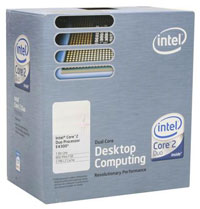 |
The least expensive Core 2 Duo processor ends up being the most sensible choice for getting the largest percentage overclocks, so compared to the entry level Intel configuration you don't even have to spend more money on this area. The E4300 has a base clock speed of 1.8GHz but uses a 200 MHz front side bus, whereas the more expensive E6300 has a 266 MHz front side bus. What that means is we don't need a motherboard or memory capable of running at insane bus speeds in order to get perhaps as much as a 100% overclock. The E6320 and E6420 will increase the amount of L2 cache while keeping the same clock speeds and bus speeds as the E6300 and E6400 respectively, but the new chips aren't available yet. Prices should also be dropping a bit more in the near future on Intel processors, so if you wait a few weeks you might be able to save another $20 or so. If you can spare the extra change, moving straight up to the E6600 can get you the best of both worlds - more cache and the ability to still reach 3.6GHz and beyond - but while that's a good choice for stock or overclocked systems, the E4300 remains the best bang for the buck in terms of pure overclocking ability.
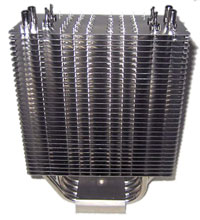 |
To aid in overclocking, we added an aftermarket heatsink. The Thermalright Ultra 120 currently sits on top of our heatsink performance charts, so it was the logical choice. In truth, the Thermalright Ultra 120 Extreme is the best air cooler we've tested so far, but we still couldn't find it in stock anywhere. It should be arriving any day now, and it shouldn't cost more than a few dollars more than the stock Ultra 120, so if you can find it in stock we would recommend that instead. Either way, CPU temperatures shouldn't be the limiting factor when it comes to overclocking with these heatsinks.
 |
Given our selection of processor, we can pretty much choose any of the midrange performance motherboards on the market and come close to our target 3.6GHz. While nForce 650i Ultra motherboards have started to show up at retail, it's a bit early to say whether or not they are truly better than the P965 platform, especially when it comes to overclocking and maturity. Since the chipset first launched six months ago, Gigabyte's GA-965P-DS3 has been a popular motherboard in this market. The latest revision improved overclocking in terms of maximum bus speeds, but here you can choose to save $15 and stick with the earlier revision, unless you plan on selecting some other parts that might allow you to reach a 500 MHz FSB. This Gigabyte board earned our Silver Editors' Choice award, and for the price it remains one of the best P965 offerings.
 |
After spending a bit more money on aftermarket cooling, we opted to cut costs in the graphics department. We mentioned the option of purchasing a GeForce 8800 GTS 320MB already, and you end up saving over $100. We'll take that route this time, selecting the PNY offering that is a standard reference card design (500/1600 clocks). If maximum gaming performance isn't a primary concern, selecting one of the newly released and less expensive GeForce 8600 GT/GTS cards is another possibility. Again, waiting to see what AMD has up their sleeve with the R600 graphics card series wouldn't be a bad idea either.
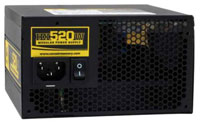 |
Considering that overclocking tends to stress systems quite a bit more than running at stock speeds, we felt the move from relatively generic power supplies to a quality aftermarket solution was warranted. We tossed around several brands, including SeaSonic and Silverstone, but in the end we selected the Corsair 520W. This power supply is anything but cheap, but we've had enough lesser power supplies fail during overclocking that we decided to be prudent and spend the money upfront rather than waste time and money swapping power supplies in the future.
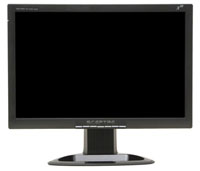 |
As an alternative to the 22" LCD we listed on the AMD gaming configuration, the Sceptre X20WC-Gamer is a 20.1" widescreen LCD that has the same native resolution as the Acer 22". With the rebate, you can save about $70 and some might argue that the Sceptre actually looks better. We wouldn't necessarily go that far, as both LCDs are pretty clearly looking to keep costs down. Which LCD do we prefer? One of the 24" LCDs, as they invariably look better and offer more features! Really, though, it's up to the individual to decide which is more important: size, price, and/or quality.
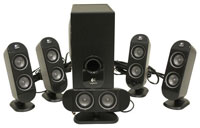 |
You may have noticed that we didn't list any sound cards on our midrange solutions. Creative's Sound Blaster X-Fi has basically been the undisputed king of gaming sound cards since it became available, but the changes made in Windows Vista in regards to sound make us hesitant to spend any extra money on a sound card right now. We've encountered at least a few systems that simply don't work properly with X-Fi cards under Windows Vista, so if you have any intention of upgrading to the new operating system you might want to hold off and only purchase a sound card once you're sure you need/want it.

















46 Comments
View All Comments
yyrkoon - Saturday, April 21, 2007 - link
I agree with Jarred somewhat, but I have always said: 'buy now, with upgrades in mind'. Meaning, if you are tired of waiting to upgrade, buy what you want now , based on what is currently availible, and make sure the components you choose, will give you as much flexability towards upgrading a CPU here, more memory there, a video card a year down the road, whatever.It has been sometime now, since you could buy parts, without feeling like you just wasted a wad of cash on something that is going to be outdated in ~6-12 months. SO . . . buy with upgrades in mind, which means everything I have said above, and 'research' on your behalf, since you are the only one who really kows what you really want/need.
JarredWalton - Friday, April 20, 2007 - link
I always tell people to wait until they don't feel they can wait any longer, because new products are always coming out. Intel will be releasing some new Core 2 models in the near future, cutting prices, etc. and AMD will be coming out with Barcelona at some point (sounding like maybe late July?) The same goes for NVIDIA and AMD/ATI. If you're ready to upgrade/buy and you need something right now, though, Then go ahead and take the plunge. I don't think Penryn is going to be as big a deal as the initial Core 2 launch - slightly faster, slightly cheaper, but nothing revolutionary (though the video encoding numbers are looking promising, and overclocking as well should be improved at least slightly).MarxMarvelous - Friday, April 20, 2007 - link
Nice article - just in time for me to start prepping for a new rig...In any case a couple of comments:
1) Re: Vista Drivers.
Personally I haven't had any issues at all with driver support. I'd say unless you have components that are 4+ years old you will be fine, especially if you are buying a brand new system.
2) Optical drive
Noticed that you are recomending a Pioneer across the board which is EIDE. SATA DVD-R drives are now around the same price and seem like a better choice.
http://www.newegg.com/product/product.asp?item=N82...">http://www.newegg.com/product/product.asp?item=N82...
JarredWalton - Friday, April 20, 2007 - link
Thanks for the heads up - I may have to get one of those for my next PC purchase. But I didn't recommend Pioneer across the board (Lite-On in the cheaper builds to save a few dollars). Personally, I just don't do enough burning to care all that much about optical drives these days. All of the drives I have work fine, and I haven't had a drive fail in a few years (knock on wood).As for Vista drivers, there are still games that have performance issues under Vista (OpenGL especially), and certain things like SLI support on various cards (6000 and 000 GeForce lines) is still missing last I heard. I know most game issues can be worked around with a bit of effort (I think there are some registry tweaks to get STALKER to run properly, for example), but that's not the same as just *working* properly. I don't like having to jump through hoops to get CrossFire or SLI to work, and I don't like constantly putzing about trying to get games to run properly. For those reasons, I'm generally shying away from Vista still. I also have at least one system that totally locks (and then BSODs on restart after the failed install) if I try to install the latest (or any version actually) X-Fi drivers, so I have to use integrated audio in Vista on that setup. I pulled the card and put it in a different system now.
It seems to me that Vista is fine for some people, but the more you push your system and applications, the more high-end your setup, the more problems people seem to have. It's mostly usable, but it still has a few more quirks than XP in my limited experience. Maybe in about six months I'll be ready to switch.
MarxMarvelous - Friday, April 20, 2007 - link
Whoops, I didn't look through all the configs so I didn't spot the Lite-On (I've pretty much decided on switching away from AMD :). Anyhow, I also don't do a whole lot of burning but was just happy to be able to switch away from those fat EIDE cables and also be a little more future proof in case I ever want to switch the drive to a mobo with no EIDE connectors (will happen someday!).As for the Vista drivers, yeah it sounds like you're definitely more on the edge (SLI/Crossfire, OpenGL, X-Fi, etc). All of the systems I'm running it on are pretty standard (either laptops or desktops using onboard audio + single video card). All have been pretty rock solid thus far (knock on wood).
ancolboy - Friday, April 20, 2007 - link
The article said it support 1333MHz, how so? MSI website never mention it. The article also said the board could allow overclock, but the board doesn't even allow user to change FSB frequency. Or did I miss something?JarredWalton - Friday, April 20, 2007 - link
Sorry - got some products mixed up and it didn't all come out right. The MSI board doesn't OC at all right now, you're right. I was debating between that and the Gigabyte S2 board, but the text didn't come out right. I've edited this now.ancolboy - Friday, April 20, 2007 - link
Thank you for clarifying it fast :) I am considering between intel or amd solution right now. Torn between performance and price, to top it up, linux compatibility.Hoping Gary's matx roundup (still writing it I guess) could help me decide which way to go.
JarredWalton - Friday, April 20, 2007 - link
If you want OC and performance, I'd say the Gigabyte S2 is probably the best bet. If you're okay with less performance, I'd seriously consider the Biostar and ASUS 690G options with an X2 processor. Quite handy with the HDMI ports as well, if that's something you're interested in.najames - Friday, April 20, 2007 - link
I would swap out the Asus M2A-VM for the Biostar TA690G for a few bucks more. It is a solid overclocker/undervolter if you are inclined. The layout on the Biostar allows for wide passive cooled video cards too, plus you can still use both PCI slots. I am actually strongly considering buying a second TA690G setup.I'd also add 2GB of RAM for only $35 more.